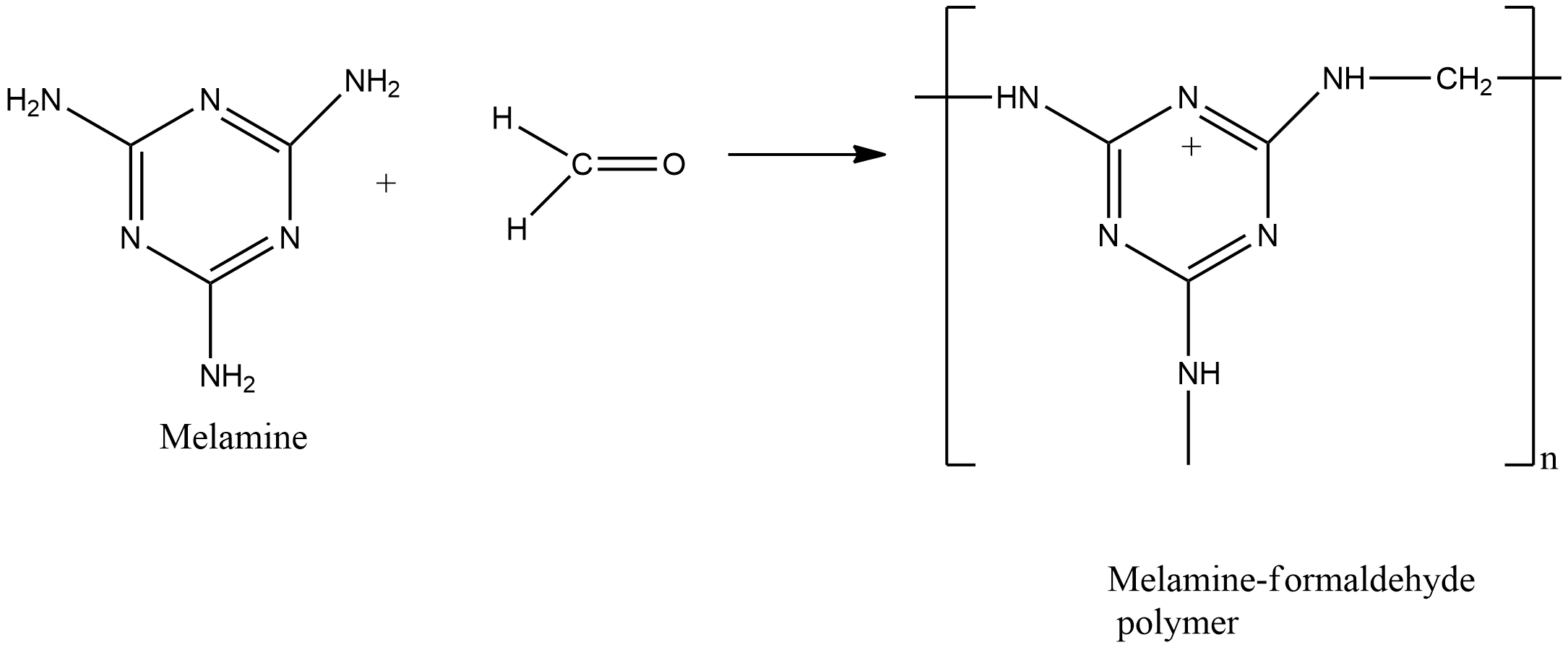
The melamine-formaldehyde resin is quite ……. polymer. The articles made from this polymer …. even dropped from a considerable height. Fill in the blanks.
Answer
561.6k+ views
Hint: Polymers are defined as that substance in which each molecule consists of a large number of simple repeating structural units joined together through covalent bonds in a regular pattern. The samples and reactive molecules from which repeating units are derived are called monomers.
Complete step by step answer:
Melamine- formaldehyde polymer is also known as Melmac and it is a condensation copolymer. It is formed by the condensation reaction of melamine and formaldehyde in an alkaline medium. Here formaldehyde acts as cross-linkers. Thus the melamine-formaldehyde resin is quite a hard polymer and the articles made from this polymer do not break even dropped from a considerable height. It is also very durable. The reaction for the formation of melamine-formaldehyde resin is given as:

Due to its hard nature, they are used to make non-breakable plastic crockeries such as cups and plates and bowls, etc. But the melamine utensils and bowls are not microwave safe. It is a thermosetting polymer that means when we heated melamine-formaldehyde polymer in a module, it undergoes a permanent change in chemical composition to give hard, infusible, and insoluble mass.
Additional information: Melamine-formaldehyde polymer is quite similar to the urea-formaldehyde polymer. It is also used for the manufacture of laminates, overlay materials, floor tiles, etc. it is also used for the manufacture of flame-resistance fibers and textiles such as fireman uniforms, thermal liners, and heat resistant gloves and aprons.
Note:
Melamine foam is a special form of melamine resin. It is used as insulating and soundproofing material and also as an abrasive.
Complete step by step answer:
Melamine- formaldehyde polymer is also known as Melmac and it is a condensation copolymer. It is formed by the condensation reaction of melamine and formaldehyde in an alkaline medium. Here formaldehyde acts as cross-linkers. Thus the melamine-formaldehyde resin is quite a hard polymer and the articles made from this polymer do not break even dropped from a considerable height. It is also very durable. The reaction for the formation of melamine-formaldehyde resin is given as:

Due to its hard nature, they are used to make non-breakable plastic crockeries such as cups and plates and bowls, etc. But the melamine utensils and bowls are not microwave safe. It is a thermosetting polymer that means when we heated melamine-formaldehyde polymer in a module, it undergoes a permanent change in chemical composition to give hard, infusible, and insoluble mass.
Additional information: Melamine-formaldehyde polymer is quite similar to the urea-formaldehyde polymer. It is also used for the manufacture of laminates, overlay materials, floor tiles, etc. it is also used for the manufacture of flame-resistance fibers and textiles such as fireman uniforms, thermal liners, and heat resistant gloves and aprons.
Note:
Melamine foam is a special form of melamine resin. It is used as insulating and soundproofing material and also as an abrasive.
Recently Updated Pages
Master Class 12 Business Studies: Engaging Questions & Answers for Success

Master Class 12 Economics: Engaging Questions & Answers for Success

Master Class 12 English: Engaging Questions & Answers for Success

Master Class 12 Maths: Engaging Questions & Answers for Success

Master Class 12 Social Science: Engaging Questions & Answers for Success

Master Class 12 Chemistry: Engaging Questions & Answers for Success

Trending doubts
What are the major means of transport Explain each class 12 social science CBSE

Which are the Top 10 Largest Countries of the World?

Draw a labelled sketch of the human eye class 12 physics CBSE

How much time does it take to bleed after eating p class 12 biology CBSE

Explain sex determination in humans with line diag class 12 biology CBSE

Differentiate between homogeneous and heterogeneous class 12 chemistry CBSE




